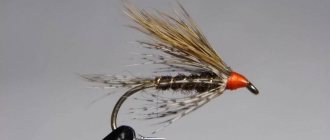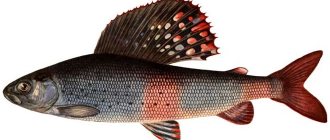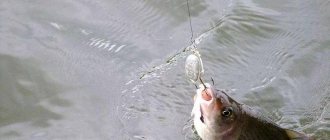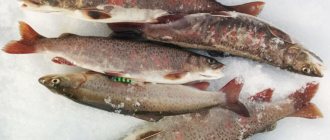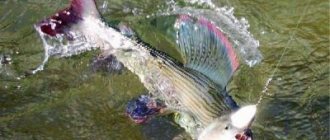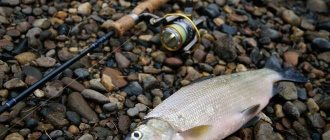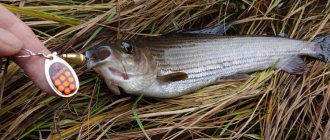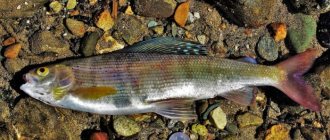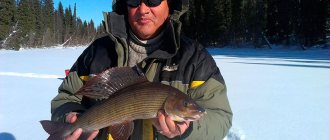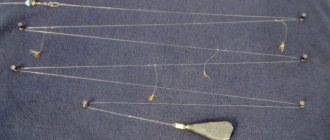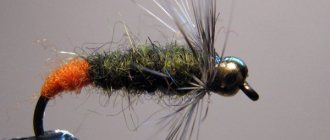Many anglers consider grayling to be a noble fish, the catching of which requires a very scrupulous approach. Any little thing that is underestimated by a beginner will lead to a complete fiasco in fishing. Of particular interest to anglers are flies for catching grayling. Having good sharp vision, the fish instantly notices inaccuracy in the artificial bait.
It is not for nothing that grayling hunters spend a lot of time studying the food supply of fish in each area. And only after this they begin to select or manufacture imitations of insects and their larvae. What is good about the fly, and what are the weaknesses of this bait?
Advantages and disadvantages, types of artificial bait
Fishermen were forced to start producing artificial insects by problems associated with the extraction and storage of natural baits. How long does it take to dig up worms or catch insects? But how to bring them alive if the path to the “black stones” is covered in several hours.
Having taken a closer look at the insects that fish love, craftsmen began tying artificial flies. It turned out that using available materials, it is possible to successfully imitate insects and their larvae. And this is the main food of grayling. The advantages of flies include:
- versatility;
- minimum weight and dimensions;
- reliable installation on the fishing line;
- long service life;
- low costs for self-production.
As for the negative aspects, many anglers categorically do not want to engage in tying flies for grayling. There is simply not enough patience, skill in handling thread and creativity. It’s a shame to lose catchy models when bitten by a toothy predator or with a dead hook.
All baits are usually divided into two groups.
- Dry flies are designed to imitate the behavior of insects that have fallen into water. Outwardly, they resemble wasps, moths, dragonflies, flies, etc. A distinctive feature of this group is the presence of fluffy plumage. For knitting dry patterns, materials such as bird feathers, fur of domestic and wild animals are used. Hooks are selected to the minimum size from thin wire.
- Wet baits should remind the fish of insects, their nymphs, and pupae that live in the water. These are water beetles, tadpoles, caddis flies, etc. A characteristic feature of wet modifications is minimal plumage combined with thick hooks. Metal wire is often used to weight the bait.
Weaving flies for catching grayling and lenok
The following types of flies are actively used in grayling fishing:
- Wet type - considered a classic type of bait, vaguely reminiscent of a water insect, larva or water beetle. Distinctive features of the product are:
- a small amount of plumage;
Possibility of tying on heavy type hooks;
- the use of metal wire to provide additional weight;
- maximum effectiveness of bait when fishing in deep areas of the reservoir;
- Can be used for fly fishing.
- Dry type - imitates a bumblebee, wasp or dragonfly that has fallen into the water. The bait is quite light and is used for fishing from the surface of a reservoir. Manufacturers produce flies made from feathers, fur or bristles. The presence of voluminous fluff allows the flies not to get wet and remain on the surface of the water even in the presence of a strong current. The distinctive features of the dry product include:
- realism of the front sight (such characteristics can be achieved by using a large number of materials in production);
the use of thin hooks when knitting, which ensures the lightness of the product;
- The high level of effectiveness of the bait is explained by the fact that grayling often floats to the surface in search of food.
- Nymph is no less popular type of bait than previous varieties. The fly most accurately copies the image of a small insect at the stage of underwater development. The main features of the product include:
- the use of lead wire to weigh the bait to the required degree, which ensures high-quality diving;
the use of rudimentary wings in the image (bird feathers are used for these purposes);
- knitting the legs of a nymph from the neck feathers of a chicken (it is very important not to build them very tightly, but to fasten them with glue).
You can achieve maximum effectiveness of the fly when fishing in deep water areas. The most popular among fishermen is the gray-brown palette of products, which provides an increased level of bite.
The dry type of flies brings maximum effectiveness in the autumn. Fishermen noted the greatest effectiveness of bait made from duck feathers.
According to a survey conducted among fishermen, the nymph made in a gray palette showed the greatest efficiency. It is recommended to use bait in late summer and late fall.
Making a soldered front sight without a machine or components
To tie this simple fly, it is not necessary to have a fly fishing laboratory with all the attributes. Many fishermen still tie flies on their knees. Some tools will be desirable. Let's get started.
Let's prepare:
- medical clamp,
- scalpel or knife,
- scissors,
- Super glue
The clamp must have spherical recesses into which the solder is placed.
Consumables are also simple:
- threads,
- lurex blue,
- red organza for plumage,
- orange thread for the head.
Hooks with soldering are used ready-made, in a variety of numbers. We clamp the solder, apply glue and form the body of the fly. We secure the last skein of thread with glue and let it dry.
We remove the remaining “tails” of threads with a scalpel. We clamp the front sight solder again, apply a drop of glue and go over the entire body with colored lurex. We make several turns at the bend of the hook and fix the Lurex with a drop of glue. After the glue has dried, remove the remaining lurex.
Let's cut off a little organza, apply a drop of glue near the solder and make a couple of turns. Let's also add glue and secure the head of the fly with a bright orange thread.
After the glue has dried, remove the excess threads. We cut off both “tails” of the organza with scissors along the bend of the hook. We straighten the organza - these are the wings of our fly.
The fly is almost ready. One wing was a little stuck together and had some glue at its base. This can be easily removed with a needle. The wings must be symmetrical.
Such flies are tied with a special knot. From the bend side of the hook, insert the fishing line into the hole.
At the end of the fishing line we knit a blind double knot-stopper and remove the excess fishing line. These flies performed well in Siberia, Transbaikalia and the Far East.
They are popular on the Kola Peninsula. Naturally, the catches are dominated by grayling, lenok, trout, all types of salmon and whitefish.
They also fish for carp fish - roach, dace, bream, ide, etc.
In winter, one tipped fly tied above a homemade spinner or balancer brings success. As a top fly it attracts bream and roach. As a rule, without adding maggots or bloodworms.
Do it yourself
If desired, artificial bait can be easily made at home. In this process you cannot do without the following materials:
- vice;
- pen holder;
- scissors;
- knotweed;
- a set of needles;
- bobbin thread holder;
- threader;
- tweezers;
- brushes for painting with paints or varnish base;
- hooks;
- mortars;
- lamps;
- mirrors;
- magnifying glasses;
- mounting thread;
- feathers (preferably rooster);
- dabbing;
- wool and lurex
Making a dry type fly
For DIY production, it is recommended to use bright orange and black hairs about 5-6 cm long.
Workflow steps:
- Remove the hook from the spoon.
- We thread the bright hairs through the ring. You can securely fix the material using a cambric. To do this, we put it on the hook ring that will be used.
- Using an ordinary needle, we fluff the fly.
- The product is ready for use.
Knitting a nymph
- Having previously prepared a size 5 hook, we secure it with a vice.
- We wind the mounting thread in a dark tone.
- Using dark brown dabbing we form the body of the insect, constructing the head and thorax.
- After wrapping the abdominal area, we leave a free part of the fur to copy the tail appendages.
- The tip of the gray feather is fixed by tying a thread near the ring. After making a few turns, we secure the mounting thread.
- We cut off the excess part of the winding using scissors.
Making a cargo front sight
- We prepare hooks numbered 6 and 7 (their shape should be curved as much as possible).
- Galvanized steel wire (0.35 mm) is placed on the shank of the hook (along the curved edge).
- The long part of the tip should hang freely near the bend of the hook, and the other end should protrude slightly beyond the eye.
- The wire wound around the hook is firmly wound with cotton type thread. Winding is carried out in one layer to the middle part of the forend. From the beginning of the ear you should make an indent of about 1 mm.
- To avoid loosening the thread, it is recommended to press it firmly against the hook.
- The short part of the tip of the wire must be bent in the opposite direction and fixed as firmly as possible to the forend.
- After this, be sure to check for free space near the eyelet on the forend. This area will become part of the structure of the insect's small head.
- After attaching the wire folded in half, we wrap the tip of the product from which the bait will be made on top of the material.
- After knitting the body of the insect, we construct a hook-hook. For these purposes, the long part of the steel wire is bent at an angle of 45 degrees. During this stage of work, it is imperative to maintain a 2 mm indent from the bottom of the insect’s body.
- Using scissors, carefully cut off the remaining wire, leaving a couple of millimeters for the tail area.
A catchable version of the Sayan type fly
- Having bent the shank of the hook, we slightly unbend the hook. These manipulations will make the hook as similar as possible to the Japanese look.
- Stepping back 2 mm from the shoulder blade, we tie the leash.
- We wrap the nodal area with thread and glue it with an adhesive base (BF-2).
- It is very important to observe the direction of the leash towards the location of the sting (perpendicular to the fore-end).
- We wrap the end part of the hook with the spatula with black thread.
- The top of the thread is coated with a varnish base. The insect head is ready!
- Let's start winding the body. To do this, a bright yellow or orange thread is wound around the forend, which will serve as the belly.
- Let's start tying the plumage (should be on the side where the sting is located). This feature allows the fly to remain very stable in the reservoir, despite the speed of the current and gusts of wind.
- When choosing artificial bait in a specialized store, you should not opt for very cheap options. Undoubtedly, you want to save money everywhere and in any situation. However, it is worth considering the fact that cheap products are made on the basis of rubber, polyethylene and plastic. Such bait has absolutely no resemblance to a real insect and the fish reacts to such obvious deception with a complete lack of interest in the product.
- You can knit insects, imitating not only a fly, but also a grasshopper, bloodworm, water beetle or dragonfly. Grayling is interested in any of the above types of prey. This is especially true for fishing in the cold season, when the fish tries to absorb everything that catches its eye.
- When making your own bait, it is very important not to forget to tie the tail. This detail is a kind of guide for bites. Pieces of woolen threads are ideal for the tail part.
- You should carefully select the shades of the front sight. Under no circumstances should a plain white palette be used in knitting. It is recommended to use knitting threads of different colors and feathers of various birds. If the feathers are plain, they can be re-dyed using aniline dyes.
- Flies with shiny threads have maximum catchability.
Source: https://ribaulov.ru/osnastka/pletenie-mushek-lovli-khariusa/
Requirements for bait for grayling
Grayling lives in various rivers and lakes of vast Russia. In each region, fish have a certain food supply to which they are genetically accustomed. There is one more point related to the seasonal preferences of grayling. It is hardly worth offering fish in early spring imitations of insects that appear in late summer. Flies for grayling must first of all meet these most important requirements. If you monitor the feeding habits of this fish from spring to autumn, you can determine the necessary parameters of artificial baits.
- In spring, grayling leads a mainly bottom-dwelling lifestyle, which is explained by the absence of anything edible on the surface of the water. During this period, the fish feed on worms, mollusks, crustaceans, eggs of spawned fish, caddis flies, and stoneflies. Accordingly, it is necessary to select a nymph for catching grayling that will resemble natural food, both in appearance and in behavior in the water. Most of the fall baits should be sinking. At the end of spring, a mass emergence of the mayfly butterfly begins in many rivers. At this point, the angler should prepare an artificial copy of the mayfly. The fly is made in a dry design, and the fly line is installed as a floating type. If you miss the moment of departure, then later it will be problematic to seduce grayling with such a model.
- In summer, you have to look for grayling in small rivers and pools, where there are deep areas after rapids. Trophy specimens are very rare to come across in hot weather. The main food in summer are insects such as ants, amphipods, flies, butterflies, and dragonfly larvae. To guess what grayling eats, experienced fishermen use gear that allows them to simultaneously cast 5-6 leashes with different baits. As soon as a fish is caught on one of the flies, the remaining baits can be gradually replaced with a more catchable variety.
In each area, the same insects may differ in color. Even this nuance must be taken into account when selecting or making bait.
Source: fishelovka.ru
If you believe search engine statistics, fishermen on the Internet most often look for answers to questions about gear. They are interested in which gear is more catchy, when this gear works, and, of course, fishing technique (retrieving, hooking, retrieving and other features of use). Among all the variety of gear and methods of fishing, such a method and even fishing philosophy (let’s not be afraid of this big word) as fly fishing is gaining more and more popularity.
RќР°С€Рё рыболовные S‚СѓСЂС‹ РЅР° хариуса!!!
Naturally, fishermen are interested in flies for catching S...P°SЂРёСѓСЃР°, ленка, trout and other types of trophy fish. To meet our readers halfway, we decided to open a section on the website about fly tying (for those who tie flies themselves) or about the rules for choosing flies (for those who buy them in specialized fishing stores or departments). All flies are adapted for fishing for grayling, whitefish, lenok, and trout in the rivers of the Northern and Subpolar Urals. Thanks to our guides, as well as clients and simply fishing enthusiasts (who, we really hope, will read these articles), this section of our website will be replenished with more and more new articles and photographs, will develop and grow, new and creative wet and dry flies for fishing will be published. fly fishing In this article, the first of this series, we simply want to show the most catchy flies in our experience for grayling, lenok and trout. All the flies described below can be tied by yourself (and thanks to their simplicity, you can tie even on a pond) or purchased at fishing stores.
Fly "Purple Chameleon"
«>
This fly was deliberately designed specifically for catching grayling and SЃРеРіР°, but, oddly enough, it worked best when catching lenok. This is quite strange, because... when knitting it, a rather small hook for lenka was used - Kamatsan B-110 No. 14. This fly was tested during SЂС‹Р±Р°Р»РєРё РЅР° реке R›РµРјРІР°, Pechora, Usa. Other bodies of water have not yet been tested.
"Beige" front sight
«>
One thing can be said about this fly - it is a mystery fly. Its main feature is that it works for a very limited period of time, and then stops working completely. Literally today, tomorrow or the day after tomorrow it is very catchy, and the next day you may not see a single bite. The “Beige” fly works only in open water and there are 2-3 “working periods” during the fishing season. Apparently, this is due to some seasonal changes in the food supply of grayling (this is what this fly works best for). We recommend that you always have such a fly in stock, especially since it is usually made of very strong hair and is very resistant to wear. When knitting it, a Kamatsan B-110 hook No. 16-14 is used.
Fly "Swamp Devil"
«>
The catchability of this fly extends mainly to lenka. When moving along the surface of the water, its whiskers give good traces in the form of a “forewater wave”, to which the large flax reacts very well. Both trout and char rarely bite on it. Overall a good working and fairly versatile fly. It was tested on the rivers of the Subpolar Urals. When knitting, use Kamatsan B-110 hook No. 10-6
Front sight "Bronze"
«>
The fly belongs to the category of classic dry flies for fly fishing for grayling. Simulates an insect hatching from a cocoon (the most vulnerable period in the life of any insect). Almost the entire fishing season is open - from June to November (naturally, we are talking about the rivers of the Urals). The hook was used from the Kamatsu B-110 size range No. 14-10.
Fly "Wine"
«>
The fly works exclusively for grayling and only for it - all other inhabitants of the Ural reservoirs ignore it. Why this happens is very difficult to say. This fly showed very good results on the реке Лемва and on the реке Хулга (no longer on the European one, but on the СЃРеР±РёСЂСЃРєРѕРіРѕ хариуса). Kamatsan B-110 hook No. 16 was used
Fly "Yellow Stripe"
«>
Probably the most incomprehensible and illogical fly presented in this article. It is not clear what it imitates and what it looks like. But, oddly enough, it is catchy and quite functional. Grayling, char, and lenok bite on it quite consistently. This fly showed excellent results on the rivers of the Subpolar Urals. It operates mainly in autumn, from September to November. Works especially well during the period of hunger (before freeze-up). Hook Kamatsu V-110 No. 16-14.
Fly "Red Ant"
«>
The Red Ant fly shows very good results on small taiga rivers, one might even say that it is more likely not on rivers, but on streams. For example, this fly worked well on the rivers RџР°РіР°, Kharuta, Grubeyu. On these rivers it “worked” very well specifically for grayling. The period of maximum results for this fly is August-November. Hook Kamatsan V-100 No. 12-14.
Fly "Lemon Stonefly"
«>
The “Lemon Stonefly” fly was tested by our fishermen on such rivers as R'ишера (in the territory of the Vishera Nature Reserve), R'елс, RљРѕР»РІР°, Ulvich. You can safely call it a grayling fly. Lenok (on the rivers of the Subpolar Urals) did not react so actively to it. A Kamatsan B-110 hook No. 14 was used.
Front sight "Lemon Ranger"
«>
This fly continues our "lemon" series (due to the color of the materials used). The fly was associated relatively recently and the statistics on it are still small. We can definitely say that this is a universal fly for grayling and it definitely has the right to a place in every fly fisherman’s kit. Her element is grayling fishing. When producing the Lemon Ranger fly, a Kamatsu B-110 hook No. 16-14 was used.
Fly "Bear tobacco"
«>
This fly has proven itself very well when catching large trophy grayling and lenok. Char and trout also do not shy away from it (but to a much lesser extent). The “Bear Tobacco” fly works well on all rivers of the Subpolar Urals (Lemva, Paga, Pechora, Usa, Kharuta, Grubeyu, RљРѕР¶РёРј, RљРѕСЃСЊСЋ, etc.). The fly works throughout the fishing season - from June to November. The Kamatsan B-110 hook No. 12-8 is used.
Fly "Olive"
«>
The author of this article can safely say that the Olive fly is his favorite fly when fishing for grayling. All fishing begins with this. “Olive” is probably the most versatile of all the flies for grayling. Its calm color scheme, small hook, simplicity of execution (which means reliability, accuracy and great wear resistance) made it the most effective when fishing for grayling on the Paga and Lemva rivers (Subpolar Urals). From time to time, lenok was also caught on it. As mentioned above, it is better to “sharpen” it for fishing for grayling, which means using a small hook Kamatsan B-110 No. 16.
Fly "Peach Stonefly"
«>
This fly showed good results during autumn fishing, when the grayling began to eat. Grayling literally swallowed it to the guts in October-November. And this despite the fact that initially it was made on Lenka with a rather large hook Kamatsu B-110 No. 12-8.
Source: nordural.ru
Looking through the search queries of users visiting the Hermit’s Blog website, I chose the most frequently encountered ones, namely flies for catching grayling, lenok, trout, etc. In this regard, we are opening a section about flies for catching fish in our Primorsky rivers and not only. Thanks to enthusiasts, these are the users of our site: romzzus and solongoy , who, without exaggeration, can be called professionals in the manufacture of all kinds of flies, including fly fishing ones, this section will develop and be supplemented as new models of flies arrive. Description of other flies for fishing on the mountain rivers of the Primorsky Territory. These fly models can be purchased in fishing stores, where guys regularly display their products.
Arsenyev: stores “ Rybachek ”, “ Berkut ”, “ Sportivny ”, “ Okhotnik ”, dep. " Fishing accessories " in the Business Center. With. Anuchino: store " Hunting Fishing Sports " p. Chuguevka : Ussuri store
You can also ask all your questions on the forum in a special section dedicated to making flies.
Purple half-chameleon. This fly was designed for catching grayling, but it worked best for lenok despite the relatively small size of the hook. It was tested on the rivers of the Primorsky Territory: Ussuri, Zhuravleka, other reservoirs were not tested in tests, there was no time for experimentation. Hook Kamatsan B-110 No. 14 Fly Beige This fly is quite mysterious, its work is observed every 2-3 years. The fly works throughout the open water season. It is made of very strong hair, which makes the fly essentially indestructible. Hook Kamatsan V-110 No. 16-14
Marsh devil The main direction of this fly for fishing is lenok, occasionally it takes char and trout. This fly was tested on the rivers of the Primorsky Territory and showed very good results. Hook Kamatsan V-110 No. 10-6
Bronze fly This version of the fly was tested on the rivers: Ussuri, Zhuravlevka, Pavlovka, Arsenyevka, where it was defined as a very catchy bait. The bronze fly has a fishing frequency, the working period is from June to November. Size range Kamatsu V-110 No. 14-10
Wine Fly This fly is designed exclusively for fishing for grayling. It showed excellent results on the Arsenyevka River; it was not tested on other rivers; there was not enough time for experimentation. Hook Kamatsan V-110 No. 16
Yellow minke whale A striking combination of colors, it is not clear what it imitates. It showed excellent performance on the rivers of the Primorsky Territory. The main working period is from September to November. Hook Kamatsan V-110 No. 16-14
Red Ant This fly showed amazing results on the Zhuravlevka and Ussuri rivers. The capture of trophy grayling and lenok almost fell into the category of “ forbidden flies ” because it exterminated all grayling. The working period of the fly is from August to mid-November. Hook Kamatsan V-100 No. 12-14.
Lemon stonefly Fly Lemon stonefly was tested on the rivers: Arsenyevka, Ussuri, Zhuravlevka, Pavlovka, grayling was excellent on it, lenka were caught much less often due to the size range, but it can also be classified as a catchable bait. Hook Kamatsan V-110 No. 14.
Lemon Ranger A very young fly. The Lemon Ranger fly was tested in November 2010 and showed VERY good results for catching grayling. Hook Kamatsan V-110 No. 16-14
The bear tobacco fly showed excellent results in catching lenka and large grayling, as well as char and trout. The Bear Tobacco fly works on almost all rivers of the Primorsky Territory, fishing frequency is from June to November. Hook Kamatsan V-110 No. 12-8
Olive fly A universal fly that gave an amazing effect on the Arsenyevka River in the second half of October to the second half of November. It was designed as a fly for grayling, but it worked perfectly on line despite the very small hook; increasing the hook size led to zero results. Hook Kamatsan V-110 No. 16
Peach Stonefly Showed catchability on many rivers of the Primorsky Territory in the period October-November. The result was shocking: at a VERY SLOW current in the river, the grayling took the fly down its throat despite the rather large hook. Hook Kamatsan V-110 No. 12-8
Video clip: How to properly tie a fly to a fishing line
Source: blogotshelnika.ru
Flies for grayling, lenok, minnow, taimen and others
Flies for grayling. More than fifteen years have passed since I tied my first fly. This business turned out to be so fascinating to me that I began to take it seriously. The production of flies proceeded, of course, in parallel with the development of fishing with them. I started on the Dnieper, managing to deceive bleak, perch, small chub, asp and saberfish with my products.
He continued his training on the mountain rivers of the Urals and Altai Territory, catching grayling and whitefish. And now I’ve been fishing, living and working in the Far East for 10 years. The abundance of mountain rivers and streams inhabited by taimen, lenok, grayling, chebak and minnow makes this region a paradise for fly fishing lovers. And the large rivers Amur and Ussuri attract with the prospect of catching local endemics - the topgazer, snakehead and yellow-cheeked fish - active, strong predatory fish that can reach 10 kg or more.
Unfortunately, due to frost, fishing in open water in the Far East is only possible for 5-7 months. The rest of the year, some anglers live with memories and dreams, while others switch to winter fishing. Some prefer winter fishing, fearing mosquitoes, midges and midges, which appear in abundance in the warm season.
The main gear in winter is a “swinger”, that is, a rigid rod approximately 40 cm long, equipped with a fishing line with a thickness of 0.3 to 0.8 mm and a lead bait with or without bait. Winter baits here have both common names and local ones, for example: balance beams, whitefishes, boots, crabs. Pieces of fish, bark beetles and boiled chum salmon caviar are used for bait.
I decided to apply my knowledge of fly tying to making winter lures. The result exceeded all expectations. Even local villagers, who used to say that in winter they don’t catch anything with “chemical flies,” as flies are called here, now use them with pleasure.
Grayling and lenok caught with flies and heavy streamers often form the basis of winter catches on a mountain river. There is already and continues to accumulate experience in using these baits in winter in the rivers of Siberia and the European part of Russia when fishing for pike perch, burbot, pike, bream, ide, and perch. Conventionally, I divided the baits into the following groups: gobies, dragonfly larvae, stoneflies, mayflies, bottom streamers, crustaceans.
“Bulls”
When designing this bait, I used the experience of making “boots” by Amur fishermen and the idea of catching pike perch under the ice with a “helicopter” by Dnieper and Volga anglers. Knowing that different types of gobies are a delicacy and even the main food for many bottom predators, I tried to choose a bait body shape that would provide the most interesting game, simulating the behavior of these fish at the bottom of the reservoir.
Many manufacturers now offer similar winter lures, but I have not yet come across ones with pectoral fins. But their presence makes the bait play more tempting, especially when the fish are inactive. To attach the pectoral fins, I drilled a 5-7mm deep hole on each side of the head, filled them with waterproof glue and inserted the tips of light brown chicken feathers, unfolding them so that their position looked most natural.
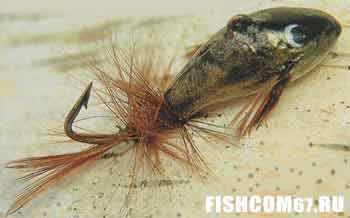
"Bull" with a tail made of rooster feathers
Then I held the bait by the hook in a fly tying machine to form a tail fin from white, gray or black domestic goat hair. To do this, I cut off a tuft of wool of the color I needed, 4 matches thick, cleaned out the fluff with a needle, and, measuring the length of the tail equal to the length of the body of the bait, cut off the excess. I secured the mounting thread to the hook, secured it with several knots and a drop of colorless varnish.
I attached the prepared bundle of wool and wound it tightly to the hook. Using a non-twisted nylon or silk thread, I formed a smooth transition from the lead body to the tail and painted everything with nail polish. It adheres quite firmly to lead, it is easy to find in stores and choose the desired color.
What happened can be seen in the photo. “Bull” turned out to be one of the most universal baits and has proven itself well on the Amur and its tributaries when catching lenok, large horse, and in the lower reaches, whitefish. There were bites of taimen, pike and burbot. Variations in bait size are possible. On the Dnieper and Volga, the “goby” in skillful hands catches pike perch well; there are often strong pulls of bream and blows from pike.
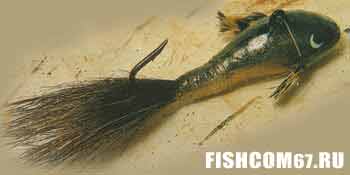
"Bull" with a tail made of goat hair
Therefore, I recommend using a small, 10 cm thin metal leash, connecting it to the bait through the smallest winding ring. If you use a thick leash plus carabiners and large winding rings, then bites are much less frequent. I have another modification of the “bull”. It differs in that it is not a tuft of goat hair that is tied as a tail fin, but a stiff rooster feather that is wound around it.
With such a “tail,” the bait moves more actively along the bottom of the reservoir, and if the fish is also active, then bites occur more often. One important feature: in order for the “bull” to move correctly, the center of gravity must be shifted back in relation to the fastening loop. Then the front part of the bait will be slightly raised and fishing will be successful.
“Dragonfly larvae”
I also came up with the next bait a long time ago and gave it the name “dragonfly larva,” fully realizing that it very vaguely resembles this insect. Nevertheless, the bait turned out to be catchy and has already brought many anglers good luck in fishing. It comes in two types: single-hook and three-hook and has more reasons than the previous model to be called a front sight.
To make it, I first cast a lead blank with a hook inserted, balanced so that the front of the blank hangs down. Then I clamp the hook in a vice and secure the mounting thread at the base of the hook. Then I attach a V-tail made from lengths of dark fishing line or goose feather segments and the end of a black, green or marsh colored chenille.

"Dragonfly Larva"
Instead of chenille, you can use thin wool threads of the same colors. I evenly wind the chenille turn to turn almost to the thickening that imitates the cephalothorax, and fix it with a mounting thread. I use it to secure one end of a strip of fury foam material, tilting it in the opposite direction from the hook. The strip should be the same width as the workpiece at the front.
On the ventral side I attach six legs, making them from the same material as the tail. At the same time, using black dabbing, I mask the cephalothorax of the bait and leave the mounting thread in the recess in front of the head. Next, I tilt the strip of secured material forward, and in the place where the fastening eyelet for the fishing line comes out, I make a slit with thin scissors, again tilt the strip of material forward and secure it with a mounting thread in front of the head.
I cut off the excess material and paint the head with black nail polish. “Dragonfly larva” showed itself well when catching lenok in quiet channels and on long stretches of the middle and lower parts of mountain rivers. If you play correctly, you can catch more than one lenka without any bait. If you are too lazy to select working wiring, you can put a small fir bark beetle on the hook at one end.
So that the insect itself (or even a piece of its skin) oscillates freely in the water with small twitches of the rod. Success is guaranteed to you, if, of course, there are fish in this reservoir. Using a “dragonfly larva”, somewhat larger in size and equipped with three hooks, my friends and I had to catch pike in the tributaries of the Amur, while there were no bites with other baits.
“Stonefly Larva”
This bait is a complex engineering structure and may well be called an artificial fly. In Far Eastern rivers, the stonefly larva sometimes reaches 6 cm in length and is the largest aquatic insect in the autumn-winter-spring period, and therefore the desired prey of many fish species. Read about winter fishing for another representative of the Far Eastern region, navaga, here.
More than once during winter fishing, the stomachs of the lenks or loaches I caught were filled with large stonefly larvae. Smaller specimens are often found in the stomachs of graylings. To make a fly, you need a hook with a long shank No. 8-2 according to the international classification and two pieces of copper wire 10 cm each. I bend one piece in half so that a small loop remains at the bend.
"Vesnyanka"
I put on a copper or black bead and fix it on the hook with a mounting thread, as if lengthening it by 50-70%. I bend the second piece of wire to form a loop 5-7 mm high and also wrap it with a mounting thread over the hook. I try to ensure that the loop itself is slightly shifted from the intended center of gravity closer to the tip of the hook. At the next stage, I use a weight to form the shape of the fly’s body and bend it slightly, pressing the front part down.
I use thin lead or copper wire as a weighting agent. I use a mounting thread to secure the end of a dark-colored silk roving and then finish forming the body with it, smoothing out all the unevenness. From the trunk of a black goose feather I cut a strip about 5-7 mm wide and press the thin end to the workpiece, directing the opposite part to the point of the hook. I secure it with a mounting thread at the beginning of the hook bend.
I form short tail processes from segments of a goose feather. I secure them with several turns of mounting thread along with the end of a piece of thin copper wire 10 cm long and a thin wool thread of black or red-burgundy color. I wind the wool thread to the loop, pass a few turns through the loop and make another 2-3 turns around the body of the bait. I clamp it with a mounting thread and cut off the excess.
After this, I tilt the strip of goose feather towards the loop and also pull it with a mounting thread in front of the loop. I make several turns around the workpiece with a thin copper wire, finally pressing the strip of feather to the belly of the fly. I again press the part of the feather that is forked at the loop to the body of the fly and on the other side of the loop I secure it with several turns of the mounting thread. Made from black polymer film (preferably not very shiny).
I cut out blanks of wing rudiments 8-10 mm wide and 17-20 mm long. Then I start preparing the legs, that is, I cut them out from segments of the same goose feather that were used to make the tail processes. From the side of the abdomen I fasten the first pair of legs and, moving the film blank close to the loop with the cutout forward, I fix it with a mounting thread, stepping back about 5 mm from the cutout. I expose and secure the second pair of legs.
I wrap everything with black dabbing and press the second piece of film with a mounting thread, also stepping back about 5 mm from the edge of the cutout. I do the same with the last pair of legs. I evenly cover the rest of the body of the fly down to the bead with black dubbing. The last stage is the formation of the head. To do this, I apply the last strip of polymer film to the front sight with the narrowed part, pointing the opposite end towards the bead, and secure it with a mounting thread.
From the same material from which the tail processes and legs are made, I cut out and put two long antennae in front with a thin part, and again I secure everything and mask it with black dabbing. I bend the film towards the ear and tighten it with the mounting thread, highlighting the intended head. I finish the front sight with several fastening units. Using thin sharp scissors, I cut out the excess film behind the resulting fly head, leaving only the lateral outgrowths of the cuticle.
The result is a fairly accurate imitation of an insect. Instead of goose feathers, you can use any thin, soft, non-shiny artificial material to cover the belly. If you take the time and manage to tie such a fly, you will get into your hands a “weapon” that will kill lenka without a miss. Where fish of other species live, whose diet includes large stoneflies, the bait described is also very useful.
Bottom streamers
Fry are always desirable prey for large fish. In addition, in winter in the Far East, larvae of pink salmon and chum salmon hatch in pebble mounds, which adult fish rake with their tails over the fertilized eggs. By the end of winter, the larvae, still with yolk sacs, become active and increasingly appear in the diet of lenok and grayling.
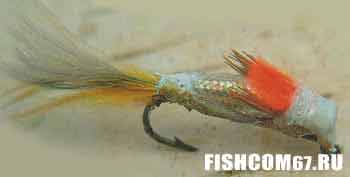
Bottom streamer with a “yolk sac”
It was this circumstance that guided me when making a streamer suitable for fishing under ice. The idea of a jig head was taken as a basis. Having given the lead weighting agent the shape of a small fish's head, I tried to make everything else from scrap materials:
- yolk sac (or gill rakers) - made of fluffed red woolen thread;
- the body is made of a strip of translucent artificial fabric (brocade) of pearl color rolled into a tube;
- the back and tail are made from solid peacock, marabou feathers or fluffed polypropylene twine, pre-painted with nail polish.
Now I am increasingly coming to the conclusion that the tail of the fry should be as soft as possible and respond to any, even the most careful play with the tackle. I paint the bait with nail polish as my imagination dictates. When fishing with a bottom streamer, there were cases when a lenok dragged away a fishing rod left unattended at the hole. The play of a streamer can be very diverse: from light, barely noticeable vibrations at the very bottom to sharp twitching in the water column, but with minimal amplitude.
“Mayfly larvae” and “crustaceans”
These flies were originally intended for fly fishing in the summer, but such aquatic organisms are a natural food for many species of fish all year round. So why not use their successful imitations when fishing in winter? I began to experiment. As a result, one of the most catchy flies in winter turned out to be the “crustacean”. Close friends called her “cockroach,” and many fishermen in Khabarovsk call her “bekarasik.”
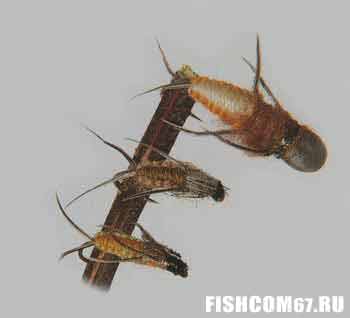
"Mayfly larvae"
To make bait, I use specially shaped Shrimp hooks, and if they are not available, I bend them myself from those available. Hooks from Mustad and Kamasan are well suited for this purpose. If they have to be bent, they do not break and retain their original strength. To make the body, I use a thin woolen thread from pale pink to bright colors, under which I fasten strips of lead wire one under the other with a mounting thread so that they are in the same plane with the shank from the inside of the hook.
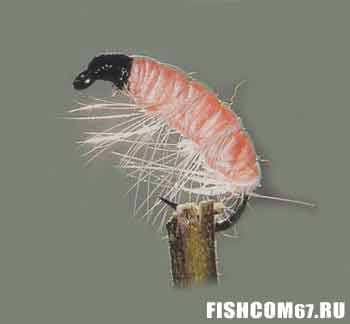
"Crawfish"
Sometimes, along with the lead wire along the hook, I wind a bright pink wool or synthetic thread of the same thickness, and on top of everything I wrap one layer of thin flesh-colored wool or synthetic thread, combing it. Then I wrap a pre-attached feather from the neck of a rooster around the body, which will imitate the legs of a “crustacean,” and press it on top with a strip of brown chicken feather, first fixed and treated for strength with colorless varnish.
At the hook ring I secure everything with several turns of mounting thread and a drop of varnish. The feather for the legs can be white, brown or striped, grizzly color, and instead of the brown feather on the back of the “crustacean” I sometimes use a strip of gray-green polypropylene. The proposed last version of the fly is interesting because after it gets wet, it becomes transparent and then a pink stripe is visible on the generally grayish flesh-colored fly.
It is this factor that is sometimes decisive when fishing for grayling, including under ice. If I came up with the methods for making all the previous baits myself, then I conscientiously “tampered” with the technique of tying a “mayfly” fly by unraveling a similar bait from a set of Mustad flies. To be more precise, it imitated, rather, a small stonefly larva with a black top and burgundy-red lower abdomen.
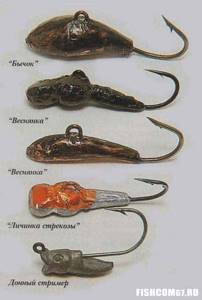
Author's lures for grayling and other fish
Having examined the contents of the stomachs of caught graylings many times, I noticed the predominance of nymphs in them - insects of dark green, black and yellow-brown colors. Moreover, the color schemes of stoneflies and mayflies are very similar. That is why my friends, for convenience, call all such flies “mayflies” and are distinguished only by the combination of colors in the color of the abdomen and the number of tail processes.
“Mayfly” turned out to be another very successful winter fly and, judging by the experience of me and my many fellow fishermen, it has great prospects ahead not only for catching grayling in the rivers of the Far East, but also for perch, ide, bream and other fish species in reservoirs of the European part of Russia. A few words about the methods of fishing from under the ice using the baits described. I think most anglers can deal with heavy “gobies”, “dragonfly larvae”, “stoneflies”, “bottom streamers” themselves.
Here it is enough to apply the experience of winter glitter. But the use of fairly light “crustaceans” and “mayflies” has its own secrets. I usually use these imitations in conjunction with one of the heavy baits listed earlier. At the end of a fishing line with a diameter of 0.25-0.30 mm I tie a “stonefly”, and 10 cm higher - a leash with a diameter of 0.12-0.16 mm with a “mayfly” or “crustacean”. If fishing takes place on a stretch with a weak current, I make a leash 5-8 cm long.
So that when playing, the fly would seem to move to the side and slowly fall towards the main line when the tackle stops. But more often I have to fish in places with a fairly fast current, then I lengthen the leash to 12-15 cm, so that when the game stops, the fly smoothly sinks to the bottom. In strong currents, sometimes it is necessary to place an additional pellet sinker in front of the fly, which does not allow the fly to constantly float in the water column. If you have to fish at a depth of more than 1 m.
Then you can tie another short leash with a fly above. To knit lures, I use improvised materials that can be found in almost any haberdashery store or household, since it is not always possible to purchase special materials for this purpose, and they are expensive. But if you try, you can get out of the situation, find a replacement for most of the materials used and successfully catch fish with your own made bait.
Front sights
Using live bait is ineffective and costly. It must be attached to a hook, which in fast water conditions and hard casts over long distances can lead to the bait slipping or being partially damaged, which reduces the effect to zero. Therefore, it has been experimentally established that it is best to use artificial bait. Buying flies for grayling in the mushki-mormyshki online store is not difficult, the choice is huge - for any type of fishing, casting method, and so on. Natural bait does not have such variety.
Flies for catching grayling are used on hooks number 4 and 7. In the summer everything is easier - this fish bites on everything. Dry flies for grayling are used for surface fishing along the current. Wet - against the flow. Nymphs - for winter (and summer, but not often) fishing at depth.
What types of flies are there?
There are several types of artificial baits for predatory fish.
- Wet - imitate aquatic or drowned insects - dragonflies, beetles, bumblebees, and so on. They are used for fly fishing against the current so that they sink slightly,
- Dry - imitate beetles, water insects, dragonflies, and so on floating on the surface. They fish with the current so that the bait does not sink, but remains on the surface,
- Nymphs - imitate insect larvae at the nascent stage, excellent flies for grayling lenka, experimentally tested fishing method - at depth or fly fishing against the current,
- Emergers - imitate almost adult insects that have just emerged from the pupa. Universal bait for winter and summer fishing,
- Streamers - imitate fish fry. Perfect for catching large predatory fish in summer in fast water, both downstream and against.
Winter flies for grayling
In winter, catching grayling or lenok can sometimes be a thankless task. Both fish bite twice a day - in the morning and in the evening. Specific biting hours vary depending on the area and type of body of water. Winter catchable flies for grayling are placed above jigs or with natural food if fishing is at depth.
European grayling is caught using lures of a catchy, bright color, with hairs and other elements. A dry fly with lurex, riding sedge and similar colors are perfect. Siberian grayling prefers more moderate colors, for example, gray riding, light green ovipositor and the like.
For deep ice fishing, you can use light gray tones or white. A classic riding style is perfect. Homemade artificial baits may be preferable if they are made by an experienced fisherman, a master of his craft for a specific area and a specific body of water. Tying flies is not an easy task due to the fact that even in different branches of the same channel, grayling and lenok bite differently.
Flies for grayling for successful fishing. Tying flies for grayling
Recently, fly fishing has become popular again. This is a very old fishing method. It is mainly distributed in European countries. There is a lot of information about flies, what shape they are, how they are tied.
But in reality, it turns out that artificial fly fishing lures are talked about in general terms. In reality, grayling flies have specific characteristics. They are divided by size and shape, and the fishing season is also important.
At different times of the year, fly fishing has its own small nuances. But first things first.
What is a "fly"?
An artificial fly, or streamer, is used as bait for predatory fish. It can be used when fishing with fly and spinning gear. Sometimes this bait is effective when fishing for bream and other peaceful species of fish, but this is more an exception than a pattern.
Anglers who are not experienced in fly fishing are always interested in the question of why predators such as trout or grayling prefer artificial flies? Perhaps the whole secret is in their availability and attractiveness. At present, flies are known for grayling, chub, lenok, and char.
In general, you can catch almost all types of fish living in mountain rivers with such artificial bait. But the king's trophy is always the big trout. Although every experienced fisherman who knows how to use a fly rod will tell you that you can catch any fish with a fly, the key here is experience.
Indeed, recently you can see fly fishermen on lakes and lowland rivers, catching roach and even crucian carp.
https://www.youtube.com/watch?v=ZRPdLe0hoIY
Almost everywhere, fishermen, using fly fishing gear, abandoned natural bait: grasshoppers, beetles, moths, wasps. This is explained by the fact that it is easier to tie flies for grayling or trout yourself or buy them than to hope that the necessary insects will be found and caught.
Where to look for them in spring or late autumn? Yes, and it’s inconvenient to mess with them. The insect's body is unlikely to withstand more than two bites. Where can you find so many wasps or bloodworms? Artificial bait is primarily practical. In addition, the fish does not care what it grabs.
During a food shortage, she pecks according to the principle: “first we’ll grab it, and then we’ll see.” Secondly, many species, including grayling, are known for their whims. Today there are bites on one fly, and tomorrow she will want another. Why this happens is unknown, but this fact is noted by all experienced fly fishers.
That’s why their boxes always contain a dozen or more different artificial baits.
Flies for grayling
When choosing a fly for grayling, you need to take into account a number of behavioral features of the fish. This species prefers small insects. It is they who force the fish to rise to the very surface of the water surface. Therefore, during most of the warm season, grayling will grab a medium-sized “dry fly” with brushes and wings.
The colors of the bait are chosen to be bright, catchy – yellow, orange, red. Catchy flies for grayling almost always have a large golden bead head. Feather wings are welcome. In early spring, before the insects fly, “wet flies” that imitate larvae perform well.
Oddly enough, it is most effective to use hooks wrapped in colored threads.
Catching grayling with a fly requires certain gear. First of all, this is a light rod. Its length is selected depending on the distance over which the casts will be made. And this factor, of course, is determined by the width of the reservoir. The wider the river bed, the further the cast.
When using a dry fly when fishing for grayling, it is better to use floating lines. But no more than seventh grade. If fishing is carried out with a “wet” streamer, then a floating line with a sinking end is used. However, you need to be guided by the nature of the current and the width of the reservoir.
You just have to be careful of the cords that are sinking along their entire length. They will negate all casts and retrieves. They are not suitable for grayling. Recently, a ten-meter tapered line has been gaining popularity among fly fishermen. Fishermen often call it “torpedo” among themselves.
They are best fished in deep areas using a nymph.
Nuances associated with the thickness of the leash
For a leash, a piece of fishing line with a diameter of up to 0.2 millimeters is almost always used. But here it should immediately be stipulated that the thickness of the leash should correspond to the hook.
For example, with a hook number 2.5, a fishing line with a diameter of 0.12 millimeters will be ineffective, and even ridiculous.
It is wise to use a leash thicker than 0.2 mm only if fishing takes place in water bodies with unfavorable conditions or if a large fish is expected as a trophy.
Features of seasonal grayling fishing
In the spring, flies for grayling are more often used not in fly fishing, but in spinning gear. This increases the chances of waiting for a predator to bite. The fly fishing method becomes effective only when there is a massive emergence of insects.
During this period, grayling literally grabs any bait from the water surface. As a rule, this is the end of May or the first ten days of June. At such times, it is best to fish with dry flies. Grayling responds well to imitation butterflies, beetles and grasshoppers.
However, a completely reliable similarity is not necessary.
In the summer, “dry flies” are used more often. But in some reservoirs it makes sense to experiment with drowning nymphs that look like larvae. But with the arrival of autumn, everything changes dramatically. The water gradually cools down, and the grayling sinks to the lower layers, closer to the bottom.
There is no longer any point in fishing with surface baits. Here you can reveal one secret of experienced fly fishermen. They don't change summer dry flies, they make them wet. How? It’s very simple – cover it with fat.
Those nymphs that acted as surface flies back in July and early August are now becoming submerged.
Winter grayling fishing
Grayling habitats are clean, fast-flowing rivers of the North and Siberia. For fishermen in the European part, it is possible to catch a harya (kharka), as the locals call this fish among themselves, only south of St. Petersburg. The main excitement for catching this fish occurs in Karelia, the Arkhangelsk region, beyond the Urals, in the vastness of the Yenisei, Baikal, Angara and all the clean and virgin small rivers of the North and East.
The peculiarities of winter fishing for grayling differ from the usual trolling for perch or jigs for roach. This is due to the living conditions of the fish. In some places in our country, for example, near large cities in the Yenisei and Angara basins, as well as in Karelia, winter grayling fishing is a fairly ordinary activity that many anglers in those places look forward to.
Fishing methods
The first key to successful spotted hunter hunting is choosing the right location strategically. As a rule, these are small rivers, lakes and large arteries of the north and Siberia. However, even in a body of water where grayling is definitely present, sometimes it is not easy to find the location of this fish from the ice.
In addition to the right tactics, you need to use special gear. Grayling is usually caught in two ways - with a regular fishing rod with a nod for playing, as well as a donka with a retractable leash and bait for the current. Large grayling are also caught on large baits along with lenok - spoons, twisters on jigs, fry on jigs.
The fishing tackle (a fishing rod with a nod, a twitch, a fly) is equipped with a heavy jig at the end, depending on the strength of the current, and a lighter suspension with a fly, solder or cambric above. The hooks are usually baited with bait - caddis fly, jig, maggot.
However, in many places, grayling is caught from the ice without bait, using winter flies, cambrics and other artificial baits. Read more about habitats, search tactics and fishing methods in the article on winter fishing for grayling from ice.
Flies for fishing grayling
Grayling flies are compact artificial baits that well imitate various insects and small larvae falling into the water. Thanks to the wide variety of factory-made and home-made models, such baits for grayling fishing are not much inferior to natural baits. The ability to use artificial flies many times makes them more convenient than live baits.
Types of flies
Flies for catching grayling, like other predominantly “fly-fishing” fish, are divided into two conventional types: wet and dry.
Wet
When knitting, not only heavy beads are used, but also larger hooks. Their plumage, unlike dry ones, is less magnificent and is often shifted towards the end of the forearm.
Wet flies are heavy, sinking lures that imitate grubs and bottom-dwelling insects. Used for wiring in the bottom layer or in the water column.
Dry
Dry flies are used for fishing from the surface during periods of active insect flight.
Such grayling baits imitate insects that have fallen into the water - small dragonflies, grasshoppers or butterflies. They have positive or neutral buoyancy and lush plumage. Knitted on thinner and lighter hooks.
Methods for catching grayling with a fly
The following gear is used for fishing:
- Fly fishing is a classic tackle for catching grayling with various flies. For grayling fly fishing, a set consisting of a 3-6 class rod with a length of 270 cm, a small inertial reel, and a 6 or 7 class cord is suitable.
- Spinning – when catching grayling with spinning tackle using such baits, use a bombard rig (sbirulino). It consists of a loaded float (the bombard itself), a chain of swivels and a 30-60 centimeter fluorocarbon leash, on which 2 to 4 different flies are attached with loop-to-loop knots.
- “Boat” is an interesting rig consisting of a floating frame to which short leashes with wet flies are tied. To cast such equipment, strong and rigid spinning or feeder rods with powerful and capacious spinning reels are used.
- “Peteryag” (“baler”) is a rig consisting of 100 meters of strong monofilament fishing line, wound evenly on the spools of two reels, with 2-3 leashes tied in its central part, on which flies are attached. The fishing technique with this equipment is simple: two anglers are located on opposite banks of the reservoir. At the same time, the main fishing line is wound equally on the reels of their spinning rods. On a section of fishing line located above the water there are leashes with baits. Their play in such gear occurs by synchronously twitching the equipment with the tips of the rods. With such manipulations, the bait repeatedly rises and falls to the surface of the water again, provoking the nearby grayling to attack.
Choosing a fly depending on the season
When choosing a fly for catching grayling, take into account the following seasonal patterns:
- In early spring, in the upper reaches of large rivers, this fish is caught using large sinking flies. This is due to the fact that the water at this time is cloudy and cold.
- In early to mid-May, when the flood turbidity gradually subsides and the water warms up to a temperature of 11-12 0C, grayling are more actively caught using dry floating flies.
- In summer, the choice of bait depends on the fishing conditions. In warm, non-rainy weather, both sinking wet flies and surface dry flies work well. After heavy rainfalls, when the water in the river becomes cloudy, sinking wet baits work better.
- In autumn and spring, grayling are more active in taking heavy and bulky sinking baits.
When choosing bait, in addition to the season, the species composition of insects in a particular area is also taken into account. The flies are selected to most realistically imitate the living creatures that the fish feed on.
On a note! Flies are used not only for catching grayling in the summer or in the off-season. Knowing the usual fishing spots, you can successfully catch grayling from under the ice using lure bait in winter.
How to tie a fly to a fishing line
The following nodes are used for tying:
- "Palomar";
- "Clinch";
- "Bloody Knot";
- Knot "Rappala";
- "Uni".
On a note! When catching grayling with these baits, fasteners and swivels are not used. This is due to the fact that excess metal elements make the equipment heavier and make it less sensitive.
Top 5 catchable flies for fly fishing for grayling
The most catchy baits of this type are the following models:
- "Red Ant"
- "Hydropsyche Nymph"
- "Loop Wing Emerger";
- "March Brown";
- "Deer Hair Caddis."
DIY flies for grayling
Making your own bait imitating caddisfly
A simple, but quite catchy imitation of a caddisfly is knitted as follows:
- A hook for tying flies is clamped in a special vice;
- An olive-colored mounting thread is wound around the shank of the hook;
- A thin copper wire 5-7 cm long, folded in half, is applied to the fore-end;
- Using reverse winding of the mounting thread from the bend to the ring, the wire is fixed to the shank of the hook;
- A long feather from the tail of a rooster is attached to the fore-end. In this case, the concave side of the feather should face outward.
- The feather is fixed by winding the mounting thread;
- Dubbing is applied to the mounting thread - for this, a bundle of this material is placed parallel to the thread. Then, using two fingers (thumb and index), carefully and tightly twist it around the thread.
- Using a mounting thread with dabbing wound around it, the body of the bait is formed;
- A feather is wound around the body, and I fix it with turns of the mounting thread;
- A piece of copper wire protruding behind the forend is wound over the turns of the mounting thread that fix the feather;
- A bunch of deer fur is placed in a mortar and its hairs are aligned by tapping it on a hard surface;
- A tuft of fur aligned in a mortar is applied to the fore-end at a slight angle. Its outermost hairs should protrude slightly beyond the bend of the hook;
- Using a mounting thread, a bunch of fur is fixed with several turns on the fore-end;
- The excess length of the fur bun from the side of the hook ring is carefully trimmed, leaving a small “stump”;
- Using a knotter, the bundle is finally fixed to the shank of the hook.
- The mounting thread that fixes the fur, as well as the ends of the hairs, are coated with a special waterproof varnish.
Important. For manufacturing, a special set of tools is used, consisting of a vice, a spool holder with a spool for mounting thread, a knotter, and a mortar for fur.
You can watch the following video to clearly describe the process:
Flies for catching grayling Link to main publication
Source: https://ribolovrus.ru/snasti/mushki-dlya-lovli-hariusa
